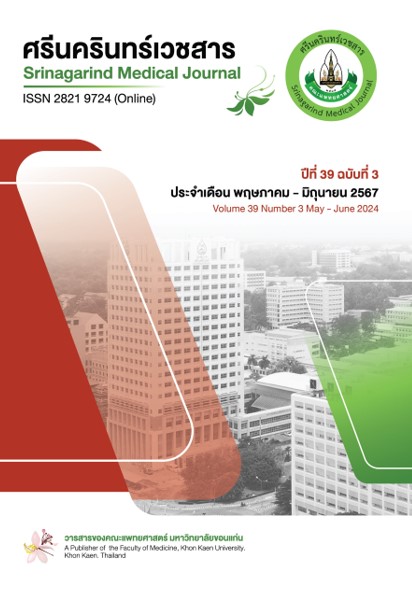ผลการรักษาผู้ป่วยที่ตรวจพบความผิดปกติระยะก่อนมะเร็งปากมดลูกด้วยห่วงไฟฟ้าในโรงพยาบาลยโสธร
คำสำคัญ:
ผลการรักษา, ตัดปากมดลูกด้วยห่วงไฟฟ้า, มะเร็งปากมดลูกบทคัดย่อ
หลักการและวัตถุประสงค์: การตัดปากมดลูกด้วยห่วงไฟฟ้า (loop electrical excision procedure: LEEP) เป็นวิธีการที่โรงพยาบาลยโสธรนำมาใช้ในการรักษารอยโรคก่อนมะเร็งปากมดลูก ซึ่งให้การรักษาโดยสูตินรีแพทย์ทั่วไป ที่ผ่านมาโรงพยาบาลยโสธรยังไม่มีการศึกษาถึงประสิทธิผลของวิธีการรักษาดังกล่าว การศึกษานี้มีวัตถุประสงค์เพื่อศึกษาผลการรักษา ความชุกและปัจจัยที่เกี่ยวข้องกับการคงอยู่หรือกลับเป็นซ้ำของรอยโรคหลังการทำ LEEP
วิธีการศึกษา: เป็นการศึกษาเชิงวิเคราะห์แบบย้อนหลังแบบมีกลุ่มเปรียบเทียบ (retrospective cohort study) กลุ่มตัวอย่าง คือ สตรีที่ตรวจพบความผิดปกติของปากมดลูก และได้รับการรักษาโดยตัดปากมดลูกด้วยLEEP ในโรงพยาบาลยโสธร ตั้งแต่เดือนมกราคม 2562 ถึงมิถุนายน 2566 จำนวน 125 ราย เก็บรวบรวมข้อมูลจากเวชระเบียนผู้ป่วย
ผลการศึกษา: กลุ่มตัวอย่าง อายุเฉลี่ย 45.0 ปี ส่วนใหญ่มีผลการตรวจ HPV DNA เป็นบวก พบเชื้อ HPV 16 ร้อยละ 35.2 ส่วน HPV 18 ร้อยละ 16.0 ผลการตรวจทางเซลล์วิทยา (cytology) พบรอยโรค CIN 2/3 ร้อยละ 66.4 ผลการตรวจชิ้นเนื้อจากปากมดลูกที่ได้จาก LEEP พบรอยโรคระยะ CIN 2/3 ร้อยละ 57.6 พบรอยโรคที่ขอบของชิ้นเนื้อ (positive margin) ร้อยละ 46.4 พบภาวะแทรกซ้อน ร้อยละ 24.0 ผลการตรวจ cytology หลังทำ LEEP พบรอยโรค CIN 2/3 ร้อยละ 25.0 และเป็นมะเร็งปากมดลูก ร้อยละ 5.7 ความชุกการคงอยู่หรือกลับเป็นซ้ำของรอยโรค ร้อยละ 36.4 (95%CI 26.4, 47.3) ปัจจัยที่สัมพันธ์กับการคงอยู่หรือกลับเป็นซ้ำของรอยโรคภายหลังการทำ LEEP อย่างมีนัยสำคัญทางสถิติ มี 2 ปัจจัย ได้แก่ 1) การมีระยะขอบโรค และ 2) ผลของการตรวจ HPV DNA
สรุป: การตัดปากมดลูกด้วยห่วงไฟฟ้า เพื่อรักษารอยโรคก่อนมะเร็งปากมดลูก ในการศึกษานี้ มีผลการรักษาและความปลอดภัยอยู่ในเกณฑ์ดี แต่ควรระมัดระวังภาวะแทรกซ้อน และการกลับเป็นซ้ำ โดยเฉพาะในกลุ่มที่มี positive margin และผลการตรวจที่พบเชื้อ HPV 16 และ HPV 18 ซึ่งจะต้องมีการติดตามผล อย่างครอบคลุมภายหลังทำ LEEP
เอกสารอ้างอิง
McCredie M, Sharples K, Paul C, Baranyai J, Medley G, Jones R SD. Natural history of cervical neoplasia and risk of invasive cancer in women with cervical intraepithelial neoplasia 3: a retrospective cohort study. Lancet Oncol 2008;9(5):425–34. doi: 10.1016/S1470-2045(08)70103-7.
World Health Organization(WHO). WHO guidelines for treatment of cervical intraepithelial neoplasia 2–3 and adenocarcinoma in situ. Switzerland; 2014.
Department of Health. Comprehensive control of cervical cancer. [Internet]. Ministry of Public Health. 2016 [cited Mar 1, 2024]. Available from: https://rh.anamai.moph.go.th/web-upload/7x027006c2abe84e89b5c85b44a692da94 /m_magazine /33336/1006/file_download/fa30505ac8be02ce3aa10a5edd41cb1b.pdf National Cancer Institute. Guidelines for screening, diagnosis and treatment of cervical cancer. Bangkok: Kosit Printing Co., Ltd.; 2018.
Obstetrics and Gynecology Department, Yasothon Hospital. Guidelines for treating cervical cancer. Yasothon; 2023.
Hillemanns P, Kimmig R, Dannecker C, Noorzai T, Thaler CJ, Hepp H. LEEP versus cold knife conization for treatment of cervical intraepithelial neoplasias. Comparative Study Zentralbl Gynakol 2000;122(1):35-42.
Santesso N, Mustafa RA, Wiercioch W, Kehar R, Gandhi S, Ahmad A, et al. Systematic reviews and meta-analyses of benefits and harms of cryotherapy, LEEP, and cold knife conization to treat cervical intraepithelial neoplasia. Int J Gynaecol Obstet 2016;132(3):266-71. doi:10.1016/j.ijgo.2015.07.026.
Khunnaronga J, Bunyasontikula N, Tangjitgamo S. Treatment outcomes of patients with cervical intraepithelial neoplasia or invasive carcinoma who underwent loop electrosurgical excision procedure. RSC Adv 2021;12(4):111–8. doi:10.14740/wjon1391
Kim BR, Kim MK, Kim YH. Effect of loop electrosurgical excision procedure on sexual dysfunction in korean women. J Korean Med Sci 2023;38(18):1–9. doi: 10.3346/jkms.2023.38.e144
D’Alessandro P, Arduino B, Borgo M, Saccone G, Venturella R, Cello A Di, et al. Loop electrosurgical excision procedure versus cryotherapy in the treatment of cervical intraepithelial neoplasia: A Systematic Review and Meta‑Analysis of Randomized Controlled Trials. Gynecol Minim Invasive Ther 2018;7(4): 145-51. doi: 10.4103/GMIT.GMIT_56_18
Santesso N, Mustafa R, Wiercioch W, Kehar R, Gandhi S, Chen Y,et al. Systematic reviews and meta-analyses of benefits and harms of cryotherapy, LEEP, and cold knife conization to treat cervical intraepithelial neoplasia Nancy. Int J Gynecol Obstet 2016;132(2016):266–71. doi:10.1016/j.ijgo.2015.07.026
Zhu M, He Y, Baak JPA, Zhou X, Qu Y, Sui L, et al. Factors that influence persistence or recurrence of high-grade squamous intraepithelial lesion with positive margins after the loop electrosurgical excision procedure: A retrospective study. BMC Cancer 2015;15(1):1–10. doi:10.1186/s12885-015-1748-1
Kanjanasirirut P, Pataradool K, Manusirivithaya S, Phaloprakarn C, Chavanisakun C. Prevalence and risk factors for positive surgical margin after loop electrosurgical excision procedure (LEEP) in patients with high grade squamous intraepithelial lesion. Thai J Obstet Gynaecol 2015;23(4):240–5.
Riibe MO, Sorbye SW, Simonsen GS, Sundsfjord A, Ekgren J MJ. Risk of cervical intraepithelial neoplasia grade 3 or higher (CIN3+) among women with HPV-test in 1990–1992, a 30-year follow-up study. Infect Agent Cancer 2021;16(1):1–9. doi: 10.1186/s13027-021-00386-z
Kilic H, Narin R, Adiguzel C, Narin MA, Sapmaz E. The effect of cervical conization on women’s sexual function and psychological health, A prospective observational study. J Sex Med 2021;19(2):257–62. doi:10.16919/bozoktip.823268
National Cancer Institute. Latest cancer statistics situation in Thailand – Thai Cancer News, TCN [Internet]. 2021 [cited May 10, 2023]. Available from: https://thaicancernews.nci.go.th/_v2/index.php/2019/12/31/kb2901li2479kj/
ดาวน์โหลด
เผยแพร่แล้ว
รูปแบบการอ้างอิง
ฉบับ
ประเภทบทความ
สัญญาอนุญาต
ลิขสิทธิ์ (c) 2024 ศรีนครินทร์เวชสาร

อนุญาตภายใต้เงื่อนไข Creative Commons Attribution-NonCommercial-NoDerivatives 4.0 International License.




